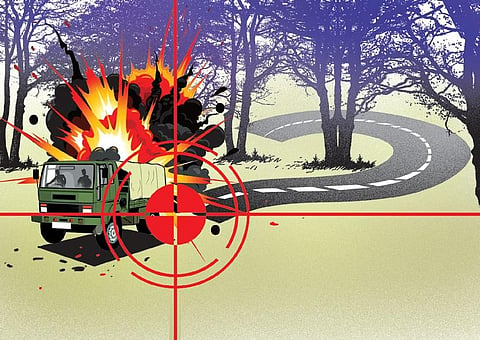

After a period of relative calm and long-term trends suggesting a sustained decline in terrorist and insurgent violence across all theatres in the country, major incidents targeting the Security Forces (SFs) were recorded in April 2023, in both Jammu & Kashmir and the Maoist insurgency areas.
On April 20, five Rashtriya Rifles personnel were killed, and one was injured, when Pakistan-backed Islamist terrorists targeted their vehicle with grenades and small arms, in the Mendhar area of the Poonch district. The lone army vehicle was transporting eatables for iftar to a nearby village in a dense forest in the Bhata Dhurian area.
On April 26, 10 personnel of Chattisgarh’s District Reserve Guards and one civilian driver, were killed in an attack by cadres of the Communist Party of India–Maoist (CPI-Maoist), in which a 50-kg Improvised Explosive Device was used to blow up a vehicle in a security force convoy, after which the rebels opened fire.
The attack took place on the Aranpur Road in the Dantewada District of Chhattisgarh, while the troops were returning from an operation targeting the top CPI-Maoist leadership present in what was a former stronghold of Maoist leader Madvi Hidma, who has been responsible for a succession of high-profile armed attacks against the SFs and has a Rs 40-lakh bounty on his head.
Much of the commentary, particularly on the Poonch incident, has chosen to highlight ‘intelligence failure’ as the cause of the losses SFs suffered. While it can be facetiously argued that any militant success amounts to a failure of intelligence, this is disingenuous and is based on a misunderstanding of the nature of intelligence.
In both incidents, operational, rather than intelligence, failures dominate. It is useful to note that in both theatres, there has been an enormous improvement in intelligence penetration, and almost all SF operations are now intelligence-based. While intelligence successes are not publicly announced, the continuous stream of operational successes, as well as the arrests, recovery of weapons caches, and reverses suffered by the militants are ample testimony to what is going on behind the scenes.
As far as the Poonch incident is concerned, clear inputs had been provided regarding the likelihood of attacks by Jaish-e-Mohammad and Lashkar-e-Taiba, though the probable targets had been identified as convoys on the Srinagar-Pulwama axis, as well as the Army Transit Camp at Badamibagh in Srinagar.
Intelligence, however, can only occasionally be specific. The information that groups of terrorists were preparing attacks was a warning across all active theatres and required added preventive action across J&K and beyond. The location of the Poonch attack had been dominated by the SFs and considered ‘safe’ for some time now. Counter-terrorism forces, however, are still located there and it is useful to recall that the Bhata Dhurian forest is a prominent infiltration route for terrorists crossing the Line of Control.
In October 2021, nine soldiers were killed in a protracted search operation in the same extended forest area. While no recent terrorist activities had been recorded in the area, the dropping of the guard was unwise.
Errors of operational assessment also mark the Dantewada debacle. The search operation had been launched on the basis of intelligence that Maoist Central Committee members were conducting meetings with People’s Liberation Guerilla Army cadres. On their return from the operation, the troops ignored standard operating procedures in areas that they considered safe, and ended up paying a price in blood. A police statement on April 29 conceded, “It was our mistake not to conduct an ROP while returning as we considered the path to be safe. Henceforth, we will use bikes after ROP or walk.”
War, it has been said, is long periods of boredom punctuated by moments of sheer terror. The tens of thousands of troops deployed in counter-terrorism and counter-insurgency operations across theatres of violence or disorder in the country go through mind-blunting routines day after day, for months on end. It is easy to be seduced into a sense that, since nothing has happened for so long, and the ground situation has changed so dramatically in favour of state forces, ‘peace’ has been established—or at least particular areas are ‘completely safe’. Such complacency is shattered, from time to time, by sharp moments of sheer terror.
There have been numberless such ‘moments’ over the year.
Yet it remains an extraordinary challenge for SF leaders to maintain the levels of relentless vigil that are required to prevent such tragic incidents. The militants have been immensely weakened across the country, but they retain residual capacities to inflict occasional carnage—and their easiest targets will be found where the SFs have lowered their guard on the assumption that a ‘safe area’ has been established. Until armed violence is completely defeated, it remains a threat everywhere.
Ajai Sahni
Executive Director, Institute for Conflict Management, South Asia Terrorism Portal
ajaisahni@gmail.com